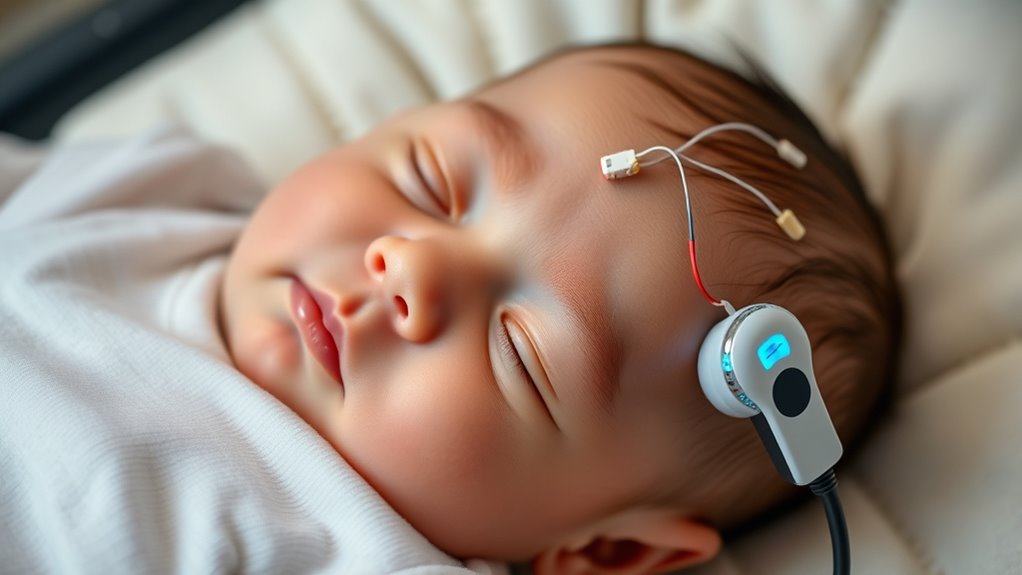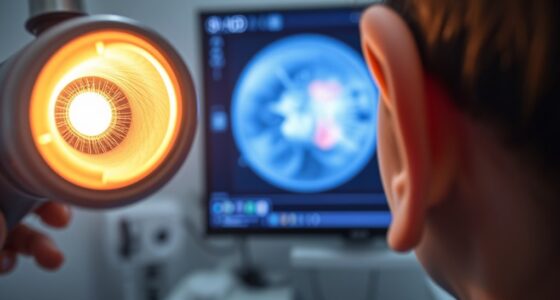During an ABR test, your baby will lie comfortably while small electrodes are placed on their forehead and near their ears. They typically remain calm or asleep, and the procedure is painless. Sounds like clicks are played through gentle earphones, and electrodes record responses to assess hearing and brain function. The test lasts about 20 to 30 minutes and is non-invasive. Keep watching to learn more about how this important test helps guarantee your baby’s healthy development.
Key Takeaways
- The test is painless, non-invasive, and usually performed while your baby is asleep or calm.
- Small electrodes are placed on the baby’s forehead and near the ears to record electrical responses.
- Sounds like clicks or tones are played through soft earphones during the test.
- The procedure lasts about 20 to 30 minutes and is designed to be comfortable for your infant.
- Results help determine if your baby’s hearing is developing normally and guide any necessary interventions.

Auditory Brainstem Response (ABR) tests are vital tools for evaluating hearing in infants, especially since they cannot reliably communicate their hearing ability. As a parent, understanding what to expect during these tests can help ease any concerns and guarantee you’re prepared for the process. ABR testing plays an essential role in assessing your baby’s hearing development, providing valuable insights into how well their auditory pathways are functioning from the earliest stages of life.
ABR tests are essential for early detection of hearing issues in infants.
The test procedures are straightforward and non-invasive. During the assessment, your infant will typically lie comfortably on a soft surface, either in your arms or on a specialized table. Small, soft electrodes are placed on their forehead, near the ears, and sometimes on the back of the head. These electrodes are painless and help pick up electrical signals generated by the auditory nerve and brainstem in response to sound stimuli. Once the electrodes are in place, you might notice your baby’s eyes fluttering or showing slight movements, but these don’t affect the accuracy of the test. The technician will then deliver a series of sounds—usually clicks or tone bursts—through small earphones placed gently in your baby’s ears.
While the sounds are played, the electrodes record the electrical activity in response to each stimulus. This process is silent to your infant, and they typically remain calm or asleep throughout the procedure. The test usually takes about 20 to 30 minutes, and during that time, the technician monitors the signals being recorded. The main goal is to observe how the auditory nerve and brainstem respond to the sounds, which provides vital data about your baby’s hearing development. Because hearing is fundamental to speech and language acquisition, early detection of any hearing issues allows for timely intervention.
Additionally, the quality of the test results can be influenced by the contrast ratio of the projector used in the room, as proper lighting conditions help ensure the technician’s focus and accuracy during the procedure. The test procedures are designed to be as comfortable as possible for your infant. Since they are asleep or very calm during the process, it minimizes stress and movement, ensuring accurate results. After the test, the results are analyzed by an audiologist or hearing specialist, who will explain whether your baby’s hearing development is typical or if further evaluation is needed. If hearing loss is detected, early intervention can considerably improve your child’s communication skills and overall development.
Frequently Asked Questions
How Long Does an Auditory Brainstem Response Test Typically Take?
You might wonder how long the test duration is for an auditory brainstem response. Typically, the procedure steps take about 1 to 2 hours, depending on the child’s cooperation. The test involves placing small electrodes on your baby’s head and playing sounds to measure their brain’s response. The process is quite quick, but factors like movement can affect the overall time. Rest assured, it’s a safe and painless procedure.
Can Infants Experience Discomfort During the Test?
Infants usually don’t experience discomfort during test procedures. The auditory brainstem response test is non-invasive and gentle, involving tiny electrodes that monitor nerve activity in response to sounds. You might worry about infant comfort, but most babies remain calm or sleep through it. The procedure is quick, so your little one won’t be distressed for long. Overall, it’s a safe process designed to guarantee accurate hearing assessment without causing discomfort.
Is Sedation Required for the Auditory Brainstem Response Test?
In the days of yore, folks believed every test needed sedation, but that’s not the case here. Sedation necessity for an auditory brainstem response test in infants is usually minimal or not required at all. Most babies tolerate the procedure well, and test discomfort is typically brief and manageable. Your healthcare provider will decide if sedation is needed based on your baby’s specific situation, ensuring safety and comfort.
When Will Parents Receive the Test Results?
You might wonder when you’ll receive the test results. Typically, the test result timeline varies, but most clinics aim to communicate results within a few days to a couple of weeks. The result communication process usually involves your healthcare provider calling you or providing a written report. Stay in touch with your child’s doctor to ensure you comprehend the findings and next steps, and don’t hesitate to ask about the expected timeline.
How Accurate Are Auditory Brainstem Response Tests in Detecting Hearing Loss?
You might wonder about hearing loss detection accuracy, and these tests are quite reliable for infants. The test’s reliability guarantees that most significant hearing issues are identified early, allowing for prompt intervention. While no test is perfect, auditory brainstem response tests are among the best tools available for detecting hearing loss in infants, giving you confidence that the results accurately reflect your child’s hearing health.
Conclusion
Understanding what to expect during an auditory brainstem response test can feel like exploring a new landscape. Remember, this test is a gentle bridge helping your little one’s hearing journey. While it might seem overwhelming at first, think of it as a lighthouse guiding you safely through the unknown. With patience and support, you’ll help your baby find their voice in the symphony of life, ensuring their future sounds are clear and bright.











